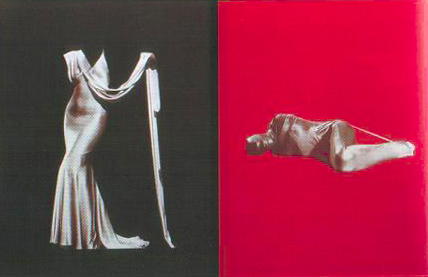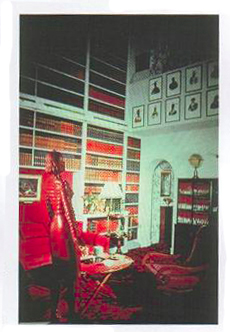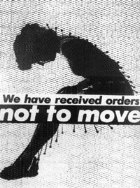
¡@
Links:






¡@
Gallery:

Sarah Charlesworth
Figures,1983
Laminated cibachrome and lacquered frames
104.1X157.5
Courtesy of Gorney
Brawin & Lee New York
Charlesworth focuses on the visual language of women magazines. She subverts the original purpose of fashion and advertising images. By isolating details of glamorized objects against lustrous monochrome backgrounds and of surrounding the whole image with lacquier frames. She combined photo fragments of a disembodied evening ground and a bounded figure completely encased in a bondage outfit. They recall Freudiau Concept of the Fetish is embraced to resolve a psychological wholeness. Charlesworth¡¦s fragmented; isolated images have the opposite effect, revealing the essential emptiness beneath the objects of male fantasy.

Laurie Simmons
Red Library#2 1983
Color photograph
Simmons explores the way in a which media images shape the imagination of prepubescent girls. Her work plays off works of dolls as surrogate through which young girls enact the shadowy rituals of adulthood. By photography cheap knock offs of the ever-popular Barbie against photographic backdrop of domestic travelogue settings. Simmons created humorous tableaux that underscore the rigidity of traditional female roles. Evokesing the picture perfect world of the era¡¦s television and advertising
Image: [Link]
The prominate role that Zahalka has given women in her _rework of M¡¦Cubbin¡¦s ¡¦Pioneer¡¦ also highlights the lack of representation of women in active, feature roles in many of the key images have helped shaped Australian identity. While the female¡¦s role as wife and mothering the ¡¥Pioneer¡¦ is important, it is the male who is shown in the more active and powerful role. The dominant role given to the male in M¡¦Cubbin painting is also evident in the fact that it is also generally assumed- title. The Pioneer refers to the male, rather than the female in the painting.
¡@

Untitled
¡§We have received orders not to move¡¨ 1982
Barbara Kruger
¡§We have received orders not to move¡¨ is superimposed on an image of an immobile women¡¦s body, pruned against a wall. The image is an invocation of social status and a feminist retort to the controlling structures of patriarchy, which perform the function of getting women in place a remark by Sigmund Freud.

Barbara Kruger
Untitled (Your body is a battleground).1989.
Poster for March on Washington. 29x24¡¨
Kruger takes and image of a women¡¦s face and half subverts it. This, with the incorporation of the word battleground, enhances the feeling of anger and/or danger of the ¡¥other¡¦ which in this case is the female gender which is represented by the feminine face. This artwork is open to a variety of interpretations. Generally, this poster was designed to chock and rise that women feel divided, represented by the halved picture, from the patriarchal society and their own (feminist) perspective on how they should control their lives. This is commentated through the word ¡¥battlefield¡¦. The red and white caption is to attracted the eye of the general public who are overlooking the march in which this poster was designed for. The stark contrast and the use of text make it easier to relate to and understand the underlining message.

Cindy Sherman
Untitled film still #27 (Fallen Women)
1978
photograph on paper 97.5X68.3
Tate
This artwork consist of a set of black and white photographs in which Sherman has costumed herself to suggest the female available in the Hollywood movies of her childhood. This artwork represent her remark that males make, and constraint what women are which make a male think about the roles of women.
¡@